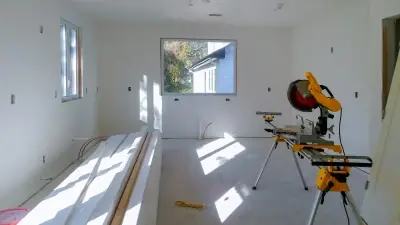Renovation Loans in California
Your friends think you’re crazy for buying that 1970s ranch with the avocado green appliances and shag carpet. They’re probably right - but here’s what they don’t understand: you see potential where they see problems. That outdated kitchen could become a chef’s dream. Those cramped rooms could open up into flowing, modern spaces. Consider purchase loan options for buying.
The challenge? Traditional financing doesn’t share your vision. Home equity loans look at your current property value - which includes those hideous avocado appliances - and say “here’s what we’ll lend you.” Usually not enough for the transformation you’re planning.
Renovation loans work completely differently. We base your loan amount on what your home will be worth after improvements, not what it’s worth right now with that 1970s time capsule kitchen. Buying a fixer-upper? Perfect. Want to gut your current place? Even better.
California’s housing market rewards smart renovators. When homes sell for $800K+, a $75K kitchen remodel that adds $100K in value becomes a no-brainer - if you can finance it properly.
Understanding Your Renovation Loan Options
Think of renovation loans as your secret weapon for accessing improvement money without draining your savings account. These specialized loans combine traditional mortgage financing with home improvement funding in ways that make financial sense.
Purchase-plus-improvements lets you buy properties needing work and finance renovations simultaneously. Perfect for those fixer-uppers where traditional buyers run away screaming. You see potential, we provide financing.
Refinance-plus-improvements works for current homeowners who want to refinance their existing mortgage while adding renovation funding. Kill two birds with one loan application.
After-renovation value lending bases your loan amount on projected property value after improvements. This usually provides way more renovation funding than traditional home equity options.
Why Do Renovation Loans Beat Other Home Improvement Financing Options?
Credit cards for home improvements? That’s expensive pain. Personal loans? Still pricey. Renovation loans let you finance improvements at mortgage rates, which typically save thousands compared to other funding sources.
Built-in project oversight ensures improvements get completed properly and add expected value. We require inspections and approved contractors because protecting your investment matters. Consider bank statement loans for contractor.
FHA 203(k) Loans: The Popular Choice
FHA 203(k) loans might be the most underrated financing tool for home improvements. Government-backed financing that accommodates both home purchases and major renovations? Count us in.
Limited 203(k) loans handle renovation projects up to $35,000 with streamlined approval processes. Think cosmetic improvements, appliance upgrades, and minor system repairs. Quick approval, minimal hassle.
Standard 203(k) loans have no maximum renovation amount and allow structural modifications. Want to add square footage, move walls, or completely transform your home? This program handles serious remodeling projects.
Low down payment requirements start at just 3.5% for borrowers with 580+ credit scores. Lower credit scores require higher down payments, but these loans remain accessible to many borrowers who can’t qualify for conventional financing. Learn more about FHA loan programs in California.
What Are the Requirements?
Here’s where FHA gets particular about details. You need detailed improvement plans before loan approval. Licensed contractors must perform most work, though some DIY projects get approval.
Timeline expectations run tight - start work within 30 days of closing, finish within six months. Sounds reasonable until you discover California’s contractor shortage and permit delays.
Interest rates run slightly higher than standard FHA loans but destroy personal loan or credit card rates for renovation funding. We’re talking mortgage rates versus credit card torture.
Conventional Renovation Loans: The Flexible Alternative
Think of conventional renovation loans as FHA 203(k)‘s sophisticated older sibling. Similar benefits, different rules, sometimes significantly better advantages depending on your situation.
Higher loan limits matter enormously in California’s expensive markets. FHA caps can strangle renovation funding when homes cost a fortune. Conventional loans breathe much easier in high-value areas.
No mortgage insurance if you put down 20% or more. Monthly savings add up fast - sometimes hundreds per month depending on your loan amount. Real money staying in your pocket.
Property type flexibility opens doors FHA slams shut. Second homes? Sometimes possible. Investment properties? Depends on the program. FHA 203(k) only works with owner-occupied primary residences.
Streamlined approval processes work magic for borrowers with strong credit and solid assets. Less paperwork hassle, faster approval timelines compared to government programs.
What Conventional Renovation Program Variations Are Available in California?
Fannie Mae HomeStyle and Freddie Mac CHOICERenovation loans basically accomplish the same goals with slightly different requirements. Nationwide availability, flexible improvement options, similar qualification hoops.
Local bank portfolio programs create hidden gems. They craft unique solutions for borrowers who don’t fit standard program guidelines. Worth exploring when cookie-cutter programs don’t work.
Cash-Out Refinance for Renovations
Want the nuclear option for renovation financing? Cash-out refinancing replaces your current mortgage with a larger loan and hands you the difference in cash for improvements. Consider refinance options for refi.
Interest rates usually beat every other renovation financing option. We’re talking purchase mortgage rates - the best pricing available for renovation money. Sometimes 3-4% lower than other options.
Maximum flexibility means exactly that. No contractor babysitting, no improvement oversight, complete project control. Use the cash however you want for home improvements.
Faster access to funds since all money becomes available at closing. No draw schedules or inspection requirements delaying project starts. Cash in hand, ready to improve.
What Should You Consider When Using Cash-Out Refinance for Renovations?
This approach works best when current mortgage rates stay competitive with your existing rate. If rates have jumped significantly since your original loan, cash-out refinancing might not make financial sense.
You lose project oversight and contractor requirements that protect your investment. Complete freedom means complete responsibility for ensuring quality work and appropriate improvements.
California Market Renovation Opportunities
California’s diverse housing stock creates excellent renovation opportunities across all price ranges. Older homes needing updates are readily available, from coastal fixer-uppers to inland properties with great bones.
Kitchen and bathroom remodels typically provide the strongest return on investment in California markets. These improvements appeal to buyers and often return 70-90% of investment costs.
Energy efficiency upgrades become increasingly valuable with California’s environmental focus. Solar panels, efficient HVAC systems, and improved insulation add value while reducing operating costs. Energy-efficient upgrades like solar panel installations can be included in renovation financing with specialized add-on programs.
Open floor plan conversions remain popular in California’s indoor-outdoor lifestyle markets. Removing walls and creating flow between spaces appeals to modern buyers.
What Regional Renovation Considerations Matter in California Markets?
Bay Area properties often justify substantial improvement investments due to high property values. $100K kitchen remodels might make financial sense when homes sell for $1.5M+. High-value properties often require jumbo financing.
Alameda County (Oakland, Fremont, Berkeley) contains diverse housing stock from Victorian-era homes in Oakland to mid-century suburban properties in Fremont. Older properties throughout the county provide renovation opportunities. Urban areas feature homes built in the 1900s-1920s, while suburban communities contain 1950s-1970s construction. Different eras require different renovation approaches.
Contra Costa County (Walnut Creek, Concord, Richmond) features predominantly post-war suburban housing stock. Ranch-style homes from the 1950s-1970s characterize many neighborhoods. Kitchen and bathroom updates represent common renovation projects in these properties. Lower median prices compared to neighboring Alameda County affect renovation budget planning.
Los Angeles County offers diverse renovation opportunities from urban condos to suburban single-family homes. Market knowledge becomes crucial for targeting appropriate improvement levels.
San Diego County benefits from year-round renovation weather and strong resale markets. Outdoor living improvements often provide excellent returns in this climate.
Working with Contractors and Managing Projects
Successful renovation projects require good contractors and realistic project management. California’s competitive construction market makes contractor selection crucial for both quality and timeline success. Consider construction-to-permanent loans for construction.
Licensed contractors aren’t just recommended - they’re required for most renovation loan programs. We verify licenses, insurance, and track records before approving any contractor for loan projects.
Detailed estimates help avoid budget surprises during renovation. Smart contractors provide line-item estimates that break down material and labor costs clearly.
Timeline management becomes critical when loan programs impose completion deadlines. Build buffer time into schedules for permit delays and material shortages that inevitably occur.
How Do You Avoid Common Renovation Project Pitfalls in California?
Scope creep kills budgets and timelines. Document all changes in writing and understand how modifications affect loan requirements and completion schedules.
Change orders happen on nearly every renovation project. Budget 10-15% extra for modifications and upgrades that seem essential once work begins.
Communication between borrowers, contractors, and lenders prevents small issues from becoming major problems. Regular progress updates keep everyone informed and projects on track.
Renovation Loan Qualification Reality
Getting approved for renovation loans means demonstrating you can handle both mortgage payments and temporary construction inconvenience. Qualification standards vary between programs but share common themes.
Credit score requirements typically start at 580 for FHA programs, 620+ for conventional options. Higher scores unlock better rates and maximum financing amounts.
Income verification must show ability to carry mortgage payments during renovation periods when homes might be partially uninhabitable. Some programs require higher income ratios than standard mortgages.
Asset requirements ensure adequate funds for project completion beyond loan amounts. Most lenders want verified reserves for potential cost overruns.
What Property and Project Standards Apply to California Renovation Loans?
Property condition must support planned improvements. Severely damaged properties might not qualify for renovation loans and require cash purchases or different financing approaches. Properties with existing unpermitted work require specialized financing before starting new renovation projects.
Improvement plans need realistic scope, timeline, and value projections. Fantasy renovations that don’t add appropriate value get rejected during underwriting review.
Local compliance with building codes, permit requirements, and contractor licensing becomes essential in California’s regulatory environment.
Maximizing Your Renovation Investment
Smart renovation planning focuses on improvements that provide the best combination of personal enjoyment and financial return. Not every upgrade makes financial sense in every market.
Market-appropriate improvements match neighborhood standards and buyer expectations. Over-improving for your area wastes money, while under-improving misses value opportunities.
Timing considerations affect both costs and convenience. Planning renovations during slower contractor seasons often reduces costs and improves timeline reliability.
Quality versus cost decisions shape both immediate satisfaction and long-term value. Investing in good materials and workmanship usually pays off through durability and resale appeal.
What Future Planning Considerations Matter for Home Renovation Financing?
Resale impact matters even if you’re not planning to sell soon. Market-friendly improvements maintain broader appeal and protect property values.
Personal lifestyle needs should drive major renovation decisions. Creating spaces you’ll actually use and enjoy provides value beyond financial returns.
Maintenance requirements for new improvements affect long-term ownership costs. Low-maintenance materials and systems often justify higher initial investments.
Next Steps for Home Renovation
Every renovation financing situation involves unique property characteristics, improvement goals, and financial circumstances. If you’re considering major home improvements, start by understanding your financing options and project requirements.
Our renovation lending team specializes in California home improvement financing and understands both property renovation challenges and lending requirements. We’ll analyze your improvement goals and recommend financing approaches that maximize your renovation potential.
California’s strong real estate fundamentals continue supporting smart home improvement investments. Call (510) 589-4096 to discuss your renovation financing needs or view all construction and renovation programs.
Explore More Construction & Renovation Options
Not sure if renovation financing fits your situation? Compare our other construction and renovation programs including construction-to-permanent loans (new builds), fix & flip loans (investment properties), bridge loans (buy before selling), and lot & land loans (property acquisition) to find the perfect fit for your California project.


